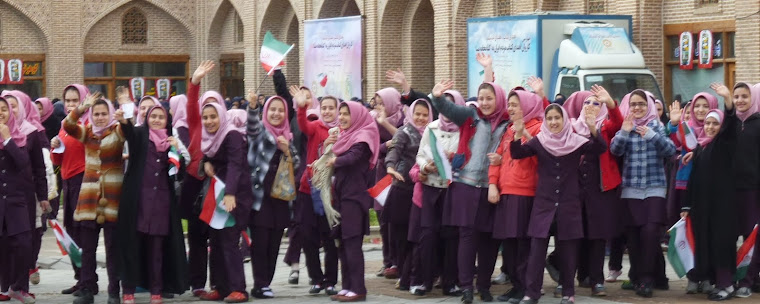We left Ardabil for Bandar-e Anzali, a harbor town of the Caspian Sea. It was the first time for me to visit that sea. I was nearly excited. The sea has a surface area of 371,000 ㎢, nearly the same size of Japan’s territory, and yet it is classed the world’s largest lake (to be exact, a closed drainage basin). The Caspian Sea was one of the top destinations on my “bucket list.”
It was a 230 km bus tour, taking almost 5 hours including lunch time. It was cloudy. Wind blew. We had to be ready for sudden changes of weather. Going through the passes of the mountainous area, we met a thick fog, but when we got down to the plain, the fog was over. Clouds were flying on the wind. Getting closer to the Caspian Sea, we saw fresh green of trees and unexpectedly paddy fields filled with water.
Our tour guide Mr. Musa said, “This coastal area is famous for rice production.” And he explained the recent situation of the Caspian Sea: “The water level is recently 28 m below sea-level without outflows. It solely depends on the inflows from the rivers around the sea.”
In other words, it depends on the relation between the rainfall of the area and the evaporation from the sea. I went to Uzbekistan in 2010 and heard of the shrinking of the Aral Sea, some 500 km east of the Caspian Sea. Formerly the one of the four largest lakes in the world with an area of 68,000 ㎢ has been steadily shrinking since the 1960s to 10% of its original size, splitting into four lakes.... The people there said, “That was environmental disaster.”
The Caspian Sea was still full of water although it was getting polluted. Mr. Musa added, “When I was a child, I came with my family for swimming in summer. Certainly, it is one of the best resorts in this area.”
Bandar-e Anzali is a seaport in northern Iran. It is said that the area has a humid climate somehow similar to that of Japan’s coast along the Sea of Japan, which I knew well. It is hot and humid in summer, on the other hand, cold with much snowfall in winter. It lacks sunshine throughout the year.
We finally arrived at a landing place of the Anzali Lagoon. It was already past 5 in the afternoon. The dark sky with thick clouds over the lagoon and beyond reminded me of that over the Sea of Japan. It looked like rain. Wearing a life-jacket, we divided and got in three motorboats.
The lagoon divides into two parts; the Selke Wildlife Refuge and the Siahkesheem Marsh. Caspian lotus (Nelumbo caspicum) grow, and the red flowers, similar to Indian lotus, would come out two months later. However, we only imagined their beauty on the dark water surface at that time.
A boatman started the engine and set out our motorboat into the lagoon. A wind died down. The water surface was calm. The boat traveled fast through a narrow waterway leaving the wake, and then suddenly appeared the broad marsh dotted with many reed beds. Our boat turned and disturbed the water. The waves were spreading and lapping against the reed grasses.
A flock of gulls were flying over the marsh. A big bird, probably Pelican, was resting his wings on a reed bed. Mr. Musa spoke loudly against the engine sounds, “This is a popular place for bird watching. Many kinds of birds live there.”
Our motorboat went into the harbor of Bandar-e Anzali where ships anchored. Mr. Musa warned us, “The harbor is also the Iranian military port. Please don’t take pictures.” We obeyed him and passed quietly by a big warship dressed with colorful flags. It may have been the Iranian new destroyer Jamaran 2, which was launched in March.
The Caspian Sea is bounded to the north by Russia, to the south by Iran, western Azerbaijan, and eastern Kazakhstan and Turkmenistan. It has been geopolitically an important water area since the ancient times.
The ancient people believed the Caspian Sea as an ocean, for it is salty as well as it appears boundless. We stayed at a seaside hotel. In the evening I got out on the hotel beach. I tasted its water. It was slightly salty and less than most seawater.
My wife and I walked on the shore and enjoyed watching gulls skimming over the water surface. It was a magnificent view.
As for dinner came out a dish of grilled sturgeon with caviar as a garnish. They were the famous products of the Caspian Sea.
The Silk Road that bridged the path between the West and East went through the north and south sides of the Caspian Sea. However, it was said that the travelers often took a shortcut by crossing that sea. I wonder whether they would eat sturgeon or caviar. Caviar has been considered a luxury delicacy, probably because the merchants on the Silk Road might have acquired its taste. For me it was the luxurious dinner once in a lifetime.

















